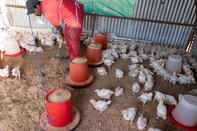
What Do They Look Like?
These biting parasites may be red, brown or black, depending on the species. Adults are 1,5 mm to 4 mm in length, flat and have well developed back legs that allow easy movement on and between hosts. The females lay up to a 100 eggs a day, on hosts or in cracks and crevices near the hosts.
Under favourable conditions, the adult cycle may last for several months. Larvae may take only two days to hatch from the eggs. They feed on the blood rich faeces of the adults and other organic material. They are are light shy, so primarily live in cracks and in nesting material.
Three larval stages exist that can take between nine days to 200 days to complete, depending on climatic conditions. The full grown larvae is about 6 mm long when it spins itself into a cocoon to later emerge as a pupae. The pupae stage takes seven to 21 days to complete.
The whole life cycle can be completed in anything from 18 days to a few months. Stick tight flea, also known as stickfast flea, are normally found on poultry birds, but they are not fussy about their hosts, so will also attach to the skins of dogs, cats, people and other animals.
The females may burrow into the skins of their hosts, until only the backside of their bodies are visible. They are quite difficult to remove, even after their death, and therefore are often mistaken with ticks. They cause painful bites that are likely to become infected. Fleas may be visible to the naked eye, they like to attach themselves to the wattles, combs and around the eyes of birds.